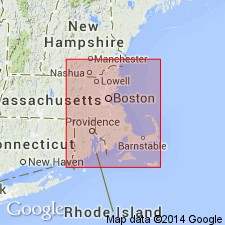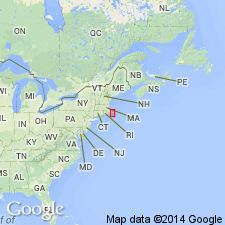
- Usage in publication:
-
- Bellingham Conglomerate*
- Modifications:
-
- Age modified
- AAPG geologic province:
-
- New England province
Summary:
Age of Bellingham Conglomerate changed from Pennsylvanian to Proterozoic Z, Cambrian, or Pennsylvanian because formation is not fossiliferous and lithologies in part resemble those in Boston basin to the north, which, according to Kaye and Zartman (1980) could be as old as Proterozoic Z. Rocks are also similar, in part, to Lower Pennsylvanian Pondville Conglomerate at base of Pennsylvanian sequence in Norfolk and Narragansett basins.
Source: GNU records (USGS DDS-6; Reston GNULEX).

- Usage in publication:
-
- Bellingham Conglomerate*
- Modifications:
-
- Overview
- AAPG geologic province:
-
- New England province
Summary:
Used as Bellingham Conglomerate of Proterozoic Z, Cambrian, or Pennsylvanian age.
Source: GNU records (USGS DDS-6; Reston GNULEX).

- Usage in publication:
-
- Bellingham Conglomerate*
- Modifications:
-
- Age modified
- AAPG geologic province:
-
- New England province
Summary:
Bellingham Conglomerate consists of conglomerate and lithic graywacke interbedded with chlorite phyllite and is confined to Bellingham basin. Also contains some volcanic rocks (rhyolite porphyry in roadcut on MA Hwy 146 at Premisy Hill west of Woonsocket, and felsite porphyry in the Franklin area east of Bellingham). Conglomerate contains pebbles of quartzite from adjacent Blackstone Group rocks and typical blue quartz of Milford Granite, so sediments are locally derived. Exposures on east side of Woonsocket Hill, southeast of Woonsocket, RI, show cliffs of steeply dipping, thin-bedded, white to gray quartzite of Blackstone Group standing above green schistose conglomerate containing many flattened white to gray quartzite pebbles and interbedded green calcareous quartz schist. Contact is probably a fault, but source of pebbles is quite obvious. In the same area, schist of Blackstone Group is difficult to distinguish from those of the Bellingham because of low-grade metamorphism of Blackstone rocks; it is probable that some of the low-grade Blackstone Rocks mapped northwest of Woonsocket in Blackstone River valley are part of Bellingham. The two rock units have been traditionally distinguished in the past by presence or absence of epidote (Warren and Powers, 1914), but this needs further study. Age is uncertain. Rocks have customarily been correlated with those of Pennsylvanian Narragansett basin; however, rocks in some exposures, such as the one at River St and Blackstone St in Woonsocket resemble Proterozoic Z Roxbury Conglomerate in Boston basin. Skehan and others (1979) suggest that Bellingham may have a similar age to that of Roxbury. This is supported by observation that Bellingham is a structural trough extending southwest from Boston basin and separating primarily Proterozoic Z granitoids from altered, but nongneissic, Proterozoic granitoids (Wones and Goldsmith, 1991). In deference to tradition, and because Proterozoic Z age has not been proven, age is shown on MA State bedrock map of Zen and others as Proterozoic Z to Pennsylvanian [map actually has age of Proterozoic Z, Cambrian, or Pennsylvanian, which differs from age stated in this report.] Report includes geologic maps and correlation charts. [Chapters A-J in U.S. Geological Survey Professional Paper 1366 are intended as explanations and (or) revisions to 1:250,000-scale MA State bedrock geologic map of Zen and others (1983).]
Source: GNU records (USGS DDS-6; Reston GNULEX).
For more information, please contact Nancy Stamm, Geologic Names Committee Secretary.
Asterisk (*) indicates published by U.S. Geological Survey authors.
"No current usage" (†) implies that a name has been abandoned or has fallen into disuse. Former usage and, if known, replacement name given in parentheses ( ).
Slash (/) indicates name conflicts with nomenclatural guidelines (CSN, 1933; ACSN, 1961, 1970; NACSN, 1983, 2005, 2021). May be explained within brackets ([ ]).

